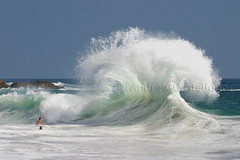
If there is such a thing as complete opposites in bass lures, fishing with a crankbait could meet that description when compared to fishing with a jig. While effective fishing with a jig can be described as slow and covering only a limited area. Fishing with a crankbait is fast paced and permits you to cover large areas of water. While a jig depends upon the anglers to create its action, the crankbait has built in action as a result of the "lips" or bills on the front of the lure which cause diving to occur as the bait is retrieved. By using lips of different sizes the angler can control the depth at which he is fishing. The larger the lip the deeper the crankbait will dive when retrieved. The lips cause the front of the lure to tip downward as it passes through the water. This downward tipping will help to protect the treble hooks that are usually present on a crankbait and help to prevent snagging as it passes by cover.
The crankbait is basically fished as the name implies. The lures is cast out and then cranked back in. This permits a large area of water to be covered in a short period of time. You should choose a crankbait according to the depth of water you are fishing. When retrieved the lure should dive deep enough to bump off the bottom and other structures it may pass. This will cause the lure to appear to be prey trying to evade capture. Varying the speed of the retrieval will also add to the action of the lure with the idea being to create evasive type movement which might trigger an instinctive strike from a fish that is not actively feeding.
Most crankbaits have the diving depth labeled when purchased. It is best to test the bait it in a known depth. If it hits bottom move into deeper water and test for contact with the bottom again. Continue to test in this manner until you no longer bump off the bottom. This will determine the true diving depth range for you lure.
Crankbaits should be paired with a slower action rod. This will give you added distance when casting and will not tend to tear the hook away after being set when your fish makes a sudden turn.
A very versatile bait, crankbaits can be used in a wide variety of situations and bass habitats. It can be used in and around brush, shallow grass beds and rocky ledges and drop offs. In short, if you select a crankbait with the proper characteristics you can fish it in just about any situation.
Ken Garrett
The author maintains a houseboat and fishes year round on Dale Hollow Lake in southern Kentucky. For more Bass fishing information go to http://gonebassfishing.com.
0 comments:
Post a Comment